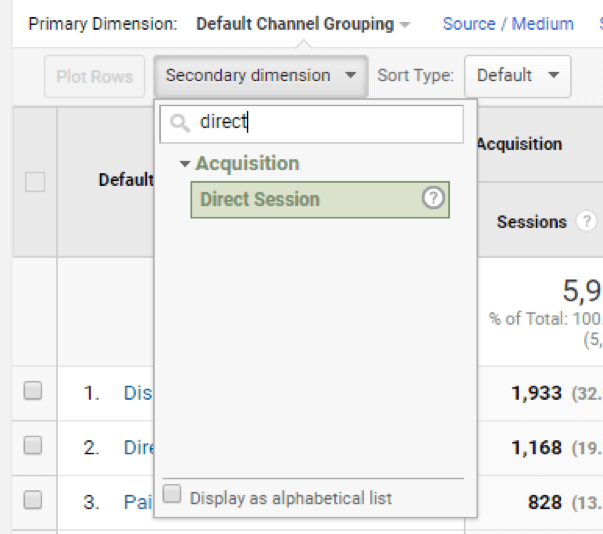Taking Full Advantage Of Search Engine Optimization with Secondary Dimension in Google Analytics
Taking Full Advantage Of Search Engine Optimization with Secondary Dimension in Google Analytics
Blog Article
Maximize Coverage Precision With Secondary Measurement in Google Analytics
Comprehending how to make best use of reporting precision with second measurements in Google Analytics can substantially enhance the depth of understandings obtained from data analysis. By including secondary dimensions purposefully, marketing professionals can uncover hidden patterns and relationships that may not be promptly apparent when evaluating key metrics alone.
Understanding Additional Measurements in Google Analytics
Second measurements enable individuals to segment and further study data beyond the primary measurement picked. While the key measurement may present the total number of page sights, including a second dimension such as 'source/medium' can give understandings into where the website traffic originated from.
Moreover, recognizing additional dimensions is important for developing much more customized records customized to details organization objectives. By picking the appropriate mix of secondary and primary dimensions, analysts can uncover patterns, fads, and correlations that may or else remain concealed. This nuanced strategy to information evaluation encourages organizations to make educated decisions based on an extensive understanding of individual behavior across different dimensions.

How to Apply Secondary Dimensions
When leveraging secondary dimensions in Google Analytics, the practical application entails selecting certain data specifications to further fine-tune understandings past the primary dimension's range. To apply second measurements efficiently, begin by accessing the record or dataset where you desire to dig deeper into the information. Within Google Analytics, locate the primary dimension that you are presently assessing. When identified, click on the dropdown food selection labeled "Second Dimension." This action will certainly reveal a listing of added parameters that can be included in your analysis. Select the secondary measurement that lines up with your logical goals, such as 'Source/Medium,' 'Device Category,' or 'Area.' By choosing an additional dimension, you can get extra thorough insights right into user behavior, demographics, or procurement networks. Keep in mind that second dimensions assist give context and granularity to your primary dimension information, enabling you to draw out even more purposeful and actionable insights from your Google Analytics reports.
Leveraging Second Measurements for Insights
Making use of second dimensions in Google Analytics permits a much more thorough evaluation of data, providing useful insights past the primary measurement's range. By leveraging additional measurements, individuals can dive much deeper into the efficiency metrics of their web site or application, uncovering hidden patterns and fads that might not be right away noticeable when just considering key measurements.
One key benefit of making use of second measurements is the ability to segment and filter data much more specifically. This can aid marketers and analysts better understand the habits of certain user sections, such as new visitors versus returning visitors, or traffic originating from various geographical places.
Moreover, second dimensions make it possible for customers to contrast and contrast different information points within the exact same report, supplying a more holistic sight of performance (Secondary Dimension in Google Analytics). Pairing the main measurement of touchdown web pages with additional dimensions like tools or demographics can reveal which pages are most effective in engaging individuals on various tools or from various demographic groups.
In essence, leveraging additional measurements in Google Analytics empowers customers to draw out richer understandings from their data, resulting in even more educated decision-making and ultimately, improved performance.
Ideal Practices for Additional Measurements
When examining data in Google Analytics, including additional dimensions effectively boosts the depth of insights derived from the primary metrics. Picking appropriate secondary measurements assists in giving context and a more clear understanding of the data being checked out.
Furthermore, it is advised to restrict the number of additional dimensions utilized in a solitary record to stay clear of frustrating the analysis with too much information. Concentrating on a few essential secondary dimensions each find more info time can lead to even more actionable and concentrated understandings. In addition, think about trying out various mixes of additional and primary dimensions to reveal unique patterns and patterns that might not appear when looking at the data in isolation.
Advanced Analysis Techniques With Secondary Dimensions
Discovering complex data connections via the calculated application of secondary dimensions can unveil nuanced understandings that boost the depth of analysis in Google Analytics. By integrating second dimensions with key information sets, advanced analysis methods can be used to draw out useful details. One such strategy is accomplice analysis, where secondary dimensions enable the segmentation of customers right into groups sharing typical features. This approach enables a much deeper understanding of individual actions patterns gradually, aiding in the recognition of fads and read review the evaluation of marketing campaigns' performance.
In addition, additional dimensions can improve the analysis of conversion courses by giving additional context. Recognizing the different touchpoints a customer communicates with prior to converting can be critical in maximizing the consumer journey - Secondary Dimension in Google Analytics. By making use of additional dimensions to delve into specifics such as traffic sources or tools used, online marketers can customize strategies to target high-converting networks efficiently
Final Thought

To enhance data analysis and gain deeper insights right into customer actions, comprehending additional measurements in Google Analytics is important - Secondary Dimension in Google Analytics. Secondary dimensions enable individuals to sector and better dissect data past the primary dimension chosen. While the primary dimension may present the complete number you can check here of page sights, adding a second dimension such as 'source/medium' can give understandings into where the web traffic stemmed from.When leveraging additional dimensions in Google Analytics, the functional application includes selecting particular data criteria to more refine understandings past the main dimension's scope. Remember that second measurements help supply context and granularity to your key measurement data, allowing you to remove more workable and purposeful insights from your Google Analytics reports
Report this page